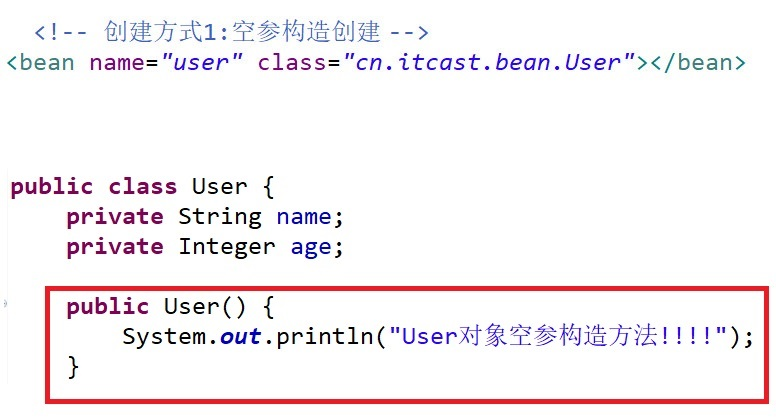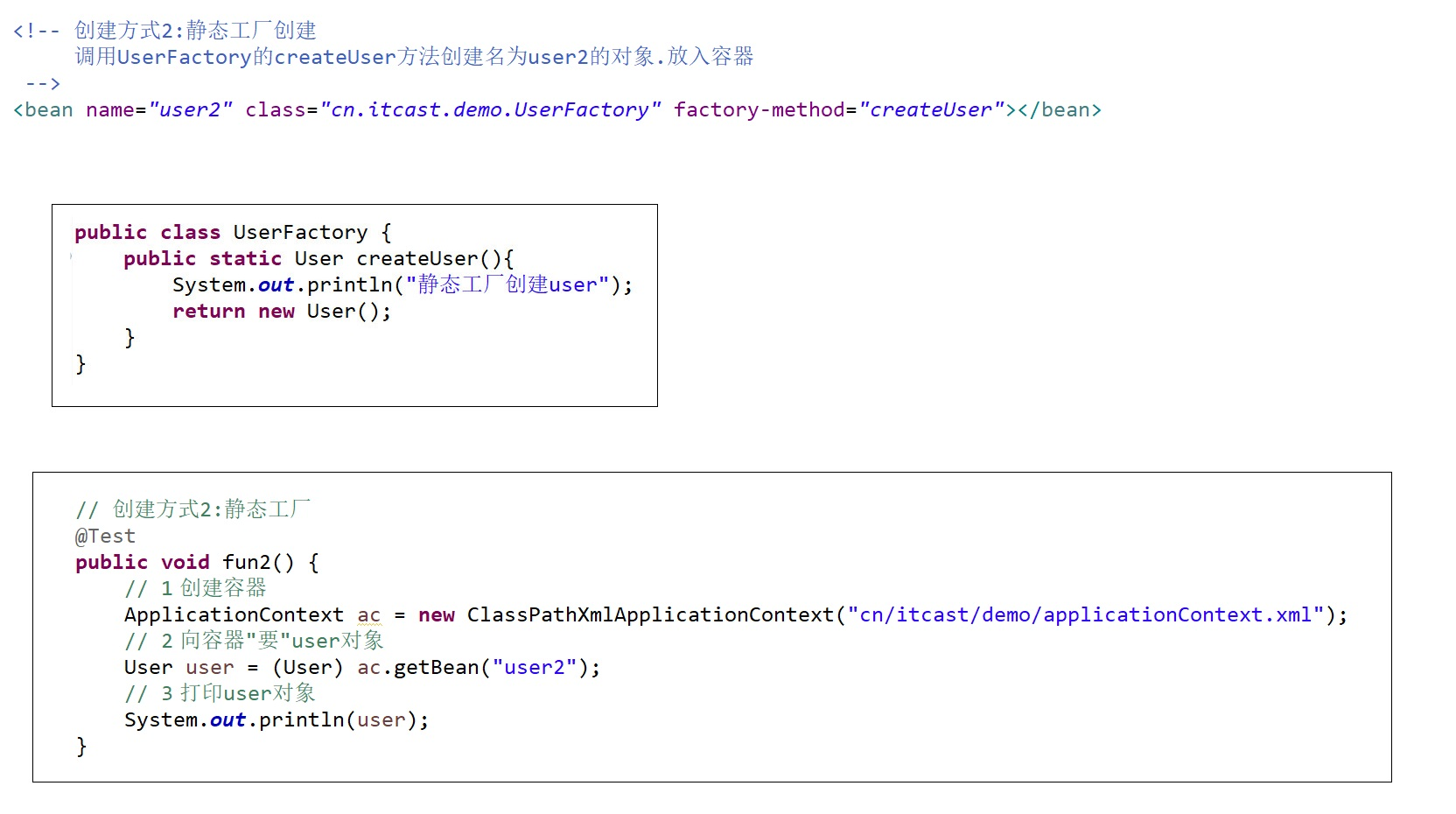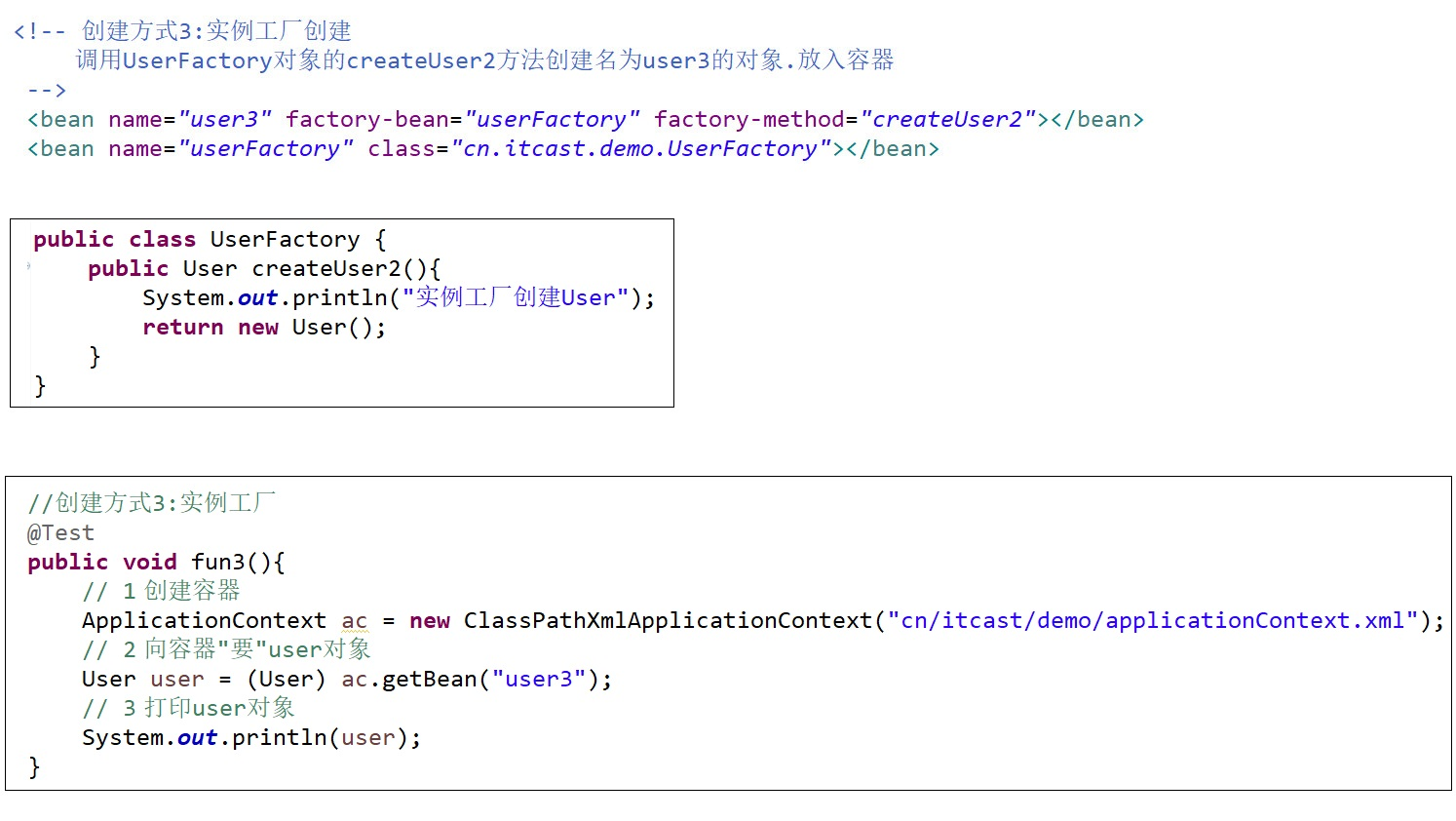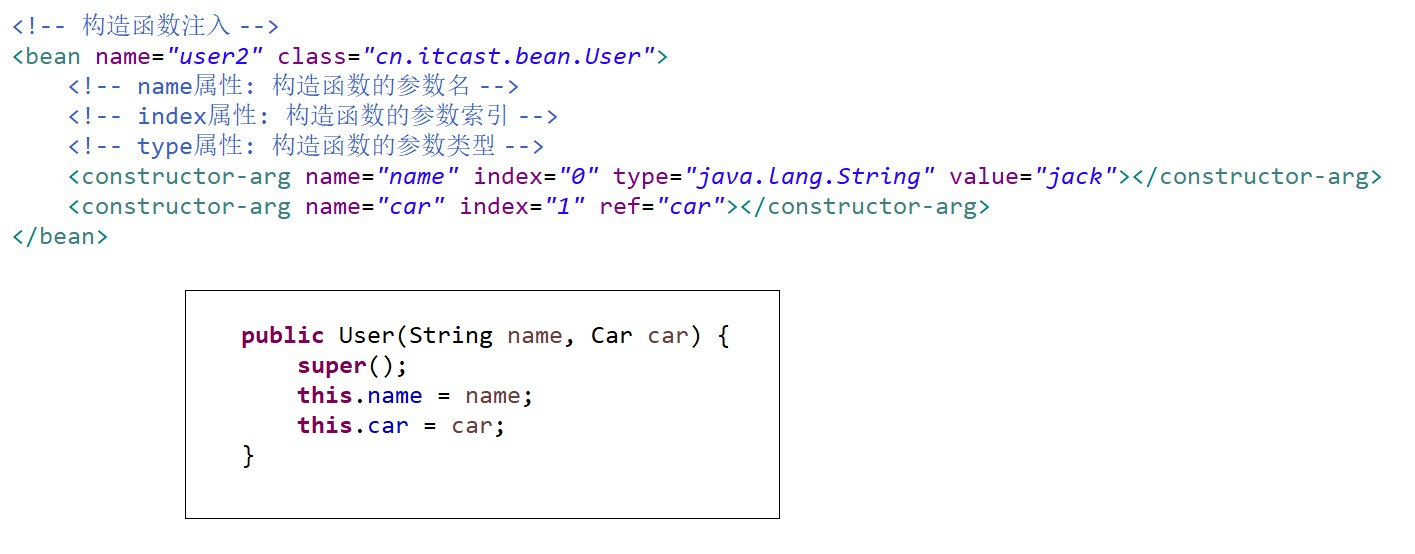一、Spring的相关配置
1.1 Bean元素
- class属性:被管理对象的完整类名
- name属性:给Bean起个名字,能重复,能使用特殊字符.后来属性
- id属性:给Bean起个名字,不能重复,不能使用特殊字符.早期属性
- scope属性
- singleton:默认值,单例对象.项目一启动就创建对象,而且容器只创建一次
- prototype:多例原型.被标识为多例的对象,每次在获得才会创建.每次创建都是新的对象(整合struts2时,ActionBean必须配置为多例的.)
- request(了解):web项目中,Spring创建一个Bean的对象,将对象存入到request域中。.对象与request生命周期一致.
- session(了解):web项目中,Spring创建一个Bean的对象,将对象存入到session域中。,对象与session生命周期一致.
- 生命周期属性(了解)
- init-method:指出初始化方法,spring会在对象创建之后立即调用
- destory-method:指出销毁方法,spring在关闭并销毁所有容器中的对象之前调用.
1.2 spring创建对象的方式
【方式一:无参数的构造方法】

spring容器启动后就创建User对象。如果对象中提供了带参构造,而没有提供无参构造,这样讲无法创建对象,程序会报错:
警告: Exception encountered during context initialization - cancelling refresh attempt: org.springframework.beans.factory.BeanCreationException: Error creating bean with name 'user' defined in class path resource [applicationContext.xml]: Instantiation of bean failed; nested exception is org.springframework.beans.BeanInstantiationException: Failed to instantiate [cn.itcast.domain.User]: No default constructor found; nested exception is java.lang.NoSuchMethodException: cn.itcast.domain.User.<init>()
【方式二:静态工厂创建】(了解)

【方式三:实例工厂创建】(了解)

1.3 Spring的分模块配置
<!-- 导入其他spring配置文件 --> <import resource="cn/itcast/demo/applicationContext.xml"/>
1.4 管理容器在项目中的生命周期
【让spring容器随项目的启动而创建,随项目的关闭而销毁】
在web.xml中配置
<!-- 可以让spring容器随项目的启动而创建,随项目的关闭而销毁 --> <listener> <!-- 注意:引入此类前,要导入spring-web-4.2.4.RELEASE.jar --> <listener-class>org.springframework.web.context.ContextLoaderListener</listener-class> </listener> <!-- 指定加载spring配置文件的位置 --> <context-param> <param-name>contextConfigLocation</param-name> <param-value>classpath:applicationContext.xml</param-value> </context-param>
【在Action中获得容器中的Service对象】
public String execute() throws Exception { // 获得spring容器=>从Application域获得即可 // 1.获得servletContext对象 ServletContext servletContext = ServletActionContext.getServletContext(); // 2.从servletContext中获得applicationContext容器 WebApplicationContext applicationContext = WebApplicationContextUtils.getWebApplicationContext(servletContext); // 3.从容器中获得CustomerService CustomerService service = (CustomerService)applicationContext.getBean("customerService"); return NONE; }
错误示例:(这样会导致每次请求都会创建新的容器)
// 创建容器 ApplicationContext applicationContext = new ClassPathXmlApplicationContext("applicationContext.xml"); CustomerService service = (CustomerService)applicationContext.getBean("customerService");
二、属性注入
2.1 注入方式
【set方法注入】
<!-- set方式注入: --> <bean name="user" class="cn.itcast.bean.User" > <!--值类型注入: 为User对象中名为name的属性注入tom作为值 --> <property name="name" value="tom" ></property> <property name="age" value="18" ></property> <!-- 引用类型注入: 为car属性注入下方配置的car对象 --> <property name="car" ref="car" ></property> </bean> <!-- 将car对象配置到容器中 --> <bean name="car" class="cn.itcast.bean.Car" > <property name="name" value="兰博基尼" ></property> <property name="color" value="黄色" ></property> </bean>
【构造函数注入】

【p名称空间注入】(了解)
<?xml version="1.0" encoding="UTF-8"?> <beans xmlns:xsi="http://www.w3.org/2001/XMLSchema-instance" xmlns="http://www.springframework.org/schema/beans" xmlns:p="http://www.springframework.org/schema/p" xsi:schemaLocation="http://www.springframework.org/schema/beans http://www.springframework.org/schema/beans/spring-beans-4.2.xsd "> <!-- p名称空间注入, 走set方法 1.导入P名称空间 xmlns:p="http://www.springframework.org/schema/p" 2.使用p:属性完成注入 |-值类型: p:属性名="值" |-对象类型: p:属性名-ref="bean名称" --> <bean name="user3" class="cn.itcast.bean.User" p:name="jack" p:age="20" p:car-ref="car" > </bean> </beans>
【spel注入】(了解)
<!-- spel注入: spring Expression Language sping表达式语言 --> <bean name="user4" class="cn.itcast.bean.User" > <property name="name" value="#{user.name}" ></property> <property name="age" value="#{user3.age}" ></property> <property name="car" ref="car" ></property> </bean>
2.2 复杂类型的注入
【数组】
<!-- 复杂类型注入 --> <bean name="cb" class="cn.itcast.c_injection.CollectionBean" > <!-- 如果数组中只准备注入一个值(对象),直接使用value|ref即可 <property name="arr" value="tom" ></property> --> <!-- array注入,多个元素注入 --> <property name="arr"> <array> <value>tom</value> <value>jerry</value> <ref bean="user4" /> </array> </property> </bean>
【list】
<bean name="cb" class="cn.itcast.c_injection.CollectionBean" > <!-- 如果List中只准备注入一个值(对象),直接使用value|ref即可 <property name="list" value="jack" ></property>--> <property name="list" > <list> <value>jack</value> <value>rose</value> <ref bean="user3" /> </list> </property> </bean>
【map】
<bean name="cb" class="cn.itcast.c_injection.CollectionBean" > <!-- map类型注入 --> <property name="map" > <map> <entry key="url" value="jdbc:mysql:///crm" ></entry> <entry key="user" value-ref="user4" ></entry> <entry key-ref="user3" value-ref="user2" ></entry> </map> </property> </bean>
【Properties】
<!-- prperties 类型注入 --> <property name="prop" > <props> <prop key="driverClass">com.jdbc.mysql.Driver</prop> <prop key="userName">root</prop> <prop key="password">1234</prop> </props> </property>
三、spring与Junit整合测试
首先要导入Junit测试包:![]()
测试代码如下:
// 帮我们创建容器 @RunWith(SpringJUnit4ClassRunner.class) // 指定创建容器时使用哪个配置文件 @ContextConfiguration("classpath:applicationContext.xml") public class Demo { // 将名为user的对象注入到user变量中 @Resource(name="user") private User user; @Test public void fun1() throws Exception { // 1.创建容器对象 // ApplicationContext applicationContext = new ClassPathXmlApplicationContext("applicationContext.xml"); // 2.向容器"要"user对象 // User user = (User) applicationContext.getBean("user"); // 3.打印user对象 System.out.println(user); } }